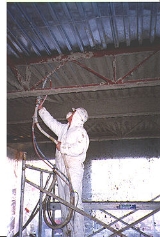
Fireproofing
Overview
Passive fire protection
Passive fire protection is an integral component of the three components of structural fire protection and fire safety in a building. PFP attempts to contain fires or slow the spread, through use of fire-resistant walls, floors, and doors...
measure, refers to the act of making material
Material
Material is anything made of matter, constituted of one or more substances. Wood, cement, hydrogen, air and water are all examples of materials. Sometimes the term "material" is used more narrowly to refer to substances or components with certain physical properties that are used as inputs to...
s or structures
Building
In architecture, construction, engineering, real estate development and technology the word building may refer to one of the following:...
more resistant to fire
Fire
Fire is the rapid oxidation of a material in the chemical process of combustion, releasing heat, light, and various reaction products. Slower oxidative processes like rusting or digestion are not included by this definition....
, or to those materials themselves, or the act of applying such materials. Applying a certification listed
Certification listing
A certification listing is a document used to guide installations of certified products against which a field installation is compared to make sure that it complies with a regulation, such as a building code...
fireproofing system to certain structures allows these to have a fire-resistance rating
Fire-resistance rating
A fire-resistance rating typically means the duration for which a passive fire protection system can withstand a standard fire resistance test. This can be quantified simply as a measure of time, or it may entail a host of other criteria, involving other evidence of functionality or fitness for...
. The term fireproof does not necessarily mean that an item cannot ever burn: It relates to measured performance under specific conditions of testing and evaluation.
Unanswered Questions

